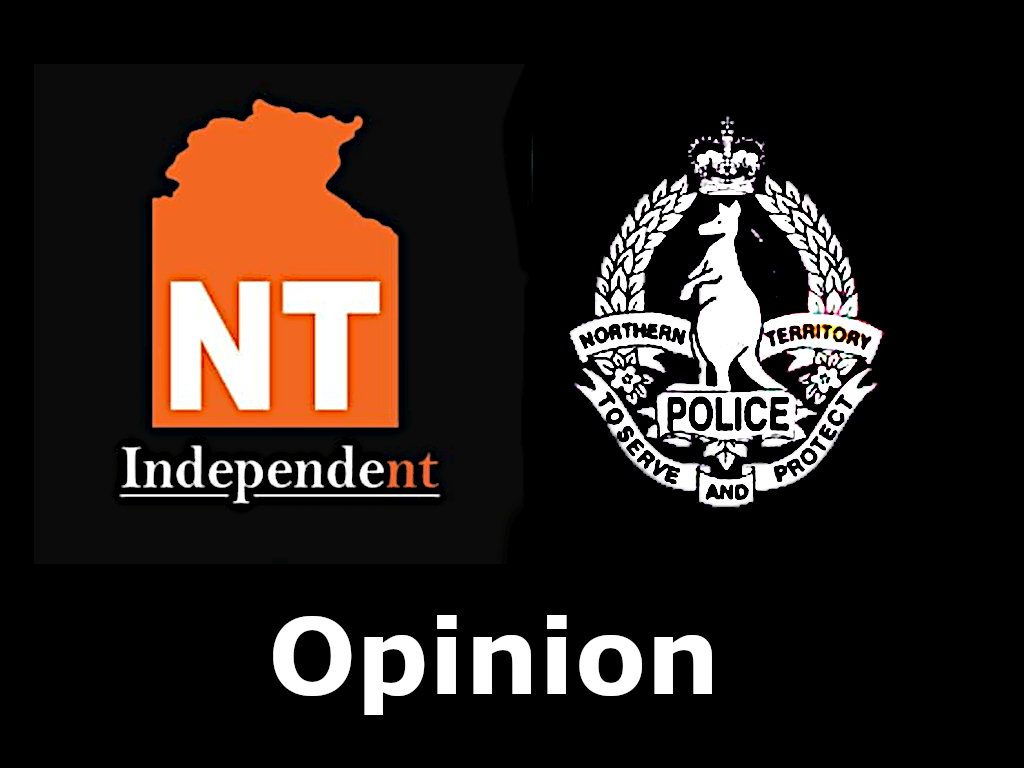OPINION: As Territorians await a coronial inquiry into the circumstances around the death of Kumanjayi Walker and details of the flawed police procedures that led to Constable Zach Rolfe being in that house in Yuendumu, one thing is certain: the NT Police cover-up is an internal arse-covering exercise of epic proportions.
From what we know thus far, through disclosures in testimony from senior officers during the murder trial, it appears the entire deployment of the Immediate Response Team (IRT) members to Yuendumu was approved with nothing more than an email requesting extra members be sent to assist in arresting Mr Walker.
This confirms that at no time was an actual risk assessment performed.
I can say from my police/tactical experience there is no way any competent supervisor would conclude, by looking at the situation as it was presented, that this was ever going to be a low-to-medium risk planned event.
The situation was too volatile and that was before the shooting.
My background is 15 years of policing, largely tactical response and as an NCTC qualified bomb technician. I have been deployed to multiple high-risk operations within the NT, nationally and internationally.
I personally worked as a team leader and trainer with the NT Police Immediate Response Team which was initially branded as the Cordon and Containment Team.
The IRT was designed as an initial response team for situations which required a higher-grade response than what the normal general duties officers would offer.
The severity of a particular situation would be determined by all relevant factors being put through a risk assessment, similar to that of everyday trades where a task is identified, risks are also identified, management for those risks listed and then an approved or not-approved outcome would be arrived at with a relevant risk rating.
An example of events that would necessitate a specialist team like IRT could include, but are not limited to:
- Planned arrest target apprehension
- Armed offenders
- Public Order
- Surveillance and reporting on above low-risk targets
- Close Personal Protection
- Special event teams
- Cordon and Containment
- Bomb response, with some members trained specifically
- Higher level security at large events
The team members were also trained in forced room entries/close quarters response, e.g. entering a dwelling to arrest a target where time or immediate threats did not allow us the luxury of waiting for a Territory Response Group team to arrive from Darwin as there is no TRG team south of Darwin.
The mandate of the team, whether it’s called Cordon & Containment or IRT, has not changed over the years, in that we were not developed to be deployed to any high-risk situation without the following factors taken into account:
- That there is an immediate threat which means waiting for TRG deployment is not feasible
- A multitude of plans were completed, approved and conveyed to all team members
- The plans are all standard template which are altered for the specific event, including arrest plans, negotiator plans, EA and DA plans.
- These plans detail all perceived outcomes and how the team was to respond to any of the identified risks/variables.
These plans are based on our mandatory general orders and standard operating procedures. These types of plans are also linked to our Siege Management Policies.
The plans require a team leader to complete, submit to a supervisor who then submits them to a TSD Superintendent (in Darwin) who reviews the plans and either alters, declines or approves.
These plans then come back to the team leader who again must consider and implement as instructed. The plans detail things such as, but not limited to, what weapons are approved, what the team roles are and what is to occur if there is an injury, offender escape stronghold, shots fired, hostages taken, negotiator being required, medical intervention plan, etc, etc, the list goes on.
From what we have seen disclosed in the court proceedings during the Rolfe murder trial, it appears the entire deployment of the IRT members to Yuendumu in November 2019 was based on nothing more than an email approving extra members to assist in arresting Mr Walker.
This confirms that at no time was an actual risk assessment performed, which would have included the following relevant facts ahead of the deployment:
- Walker had removed all tracking devices
- Walker had been at large for some time
- Walker had a considerable criminal history
- Walker was believed to have been attacking and illegally entering medical staff dwellings
- Medical staff were terrified and at such a level of risk that they had been ordered to leave the community
- Walker previously attacked police with an axe when they attempted to arrest him
- Walker displayed ability and willingness to utilise lethal force to avoid apprehension
- The local police were not willing to try to apprehend him due to his aggression/threat level
- In the event that an officer, Walker or a civilian were injured during any arrest attempts there is zero medical staff in the community to assist.
If any leader/supervisor would assess those facts and deem this planned police response as less than high-risk, they should not be employed in any policing role.
The risks clearly show that Constables Rolfe and Eberl, and the rest of the IRT members and dog handler, were deployed to Yuendumu to locate and arrest Walker in circumstances that are 100 per cent against all of our mandatory deployment rules and requirements.
A proper plan for arrest involves TRG
Tactical IRT plans, which I have developed and carried out after successful approval in circumstances such as this, would never have allowed two officers to be walking in and out of dwellings looking for a high-risk offender who is potentially lethally armed. Proper plans would have involved the following as a general outline.
The Territory Response Group would have been approved and a four-to-six-man team organised to attend Yuendumu ASAP. The cordon IRT team would have been dispatched from Alice Springs as extra staff to assist and run the cordons and provide general support to the TRG team.
The team would have been dispatched with less than lethal weapons such as gas munitions, bean bag shotguns and distraction devices.
There would have been no less than four members entering any dwelling where Walker was suspected to be located, with another two-to-four members outside as a cordon.
There would have been confirmation from the local Yuendumu station Sergeant that their station had the required medical kits, defibrillators and most likely would have had a remote ambulance sitting just outside of Yuendumu in case an officer or someone else was injured during the operation to convey them immediately to the Yuelamu medical centre.
I have absolutely no doubt in my mind that had the planned response been completed with the correct risk assessment and subsequent planning, TRG would have been deployed, Walker would still most likely be alive and Rolfe’s professional life would not be in ruins. Not to mention that following proper procedure would have negated all the other issues this event has created.
NT Police executive management errors covered up, blame directed at Rolfe
The NTPOL executive management is and has worked extremely hard to keep their fundamental errors hidden from the public and from the Walker family, who so far are only holding Constable Rolfe responsible, which is troubling and unfair.
This is why during the recent trial you saw executive members on the stand making comments like, “I did not see the footage of Walker attacking officers with an axe”; or, “I did not look at Walker’s PROMIS records/history before agreeing to send the IRT to arrest him”.
What those statements show is exec members attempting to convey that they did not complete any risk assessment or form the opinion Walker was a high-risk target as they did not view or investigate him at all before agreeing to send in the IRT. From my experience, this approach is a way for the executive members involved to say we didn’t do any of the required high risk response plans or seek approvals as they did not have knowledge of the information to develop a mind-set that Walker was high risk.
This is also why so much effort went into hiding/redacting the Scott Pollock coronial report. Pollock earned a reputation as one of the most highly credible and ethical investigators the nT Police had, who would have also clearly identified the errors without fear or favour. That report would highlight the management misconduct, dereliction of duty and non-compliance involving the circumstances of the IRT deployment.
The above mentioned events and deployment issues are the main reasons we saw non-disclosure agreements forced on investigators and attempts to hide investigation records and coronial reports.
Again, this is why the impending coronial must not be allowed to progress without independent investigators. It risks covering up the fundamental errors that led to that unfortunate incident in Yuendumu by those involved who know that NT Police exec staff are to blame for how this all went down.
Mr Walker’s family, Mr Rolfe’s family and the community need the truth and as promised it needs to be the result of an independent investigation, which is what the former chief minister promised all Territorians and the good people of Yuendumu.
We have all been manipulated into targeting our attention at a young NT Police officer and a young Indigenous man whose fates tragically collided, which is a misguided plan to divert us from the truth: that senior NT Police figures stuffed this up and said whatever they could to keep their jobs.
And remember, to this day nobody has been held accountable for what happened that evening in Yuendumu.
We as a community need to ensure that the deployment and the outcome are correctly assessed by the upcoming coronial inquiry so that changes are made to ensure this does not ever happen again and those responsible are held to account.
Carey Joy is a former NT Police officer who worked in the Territory Response Group (TRG), led the Immediate Response Team’s (IRT) initial task force, and was also a federal agent in the Tactical Response Team (TRT), a national and international police tactical group working on deployments around Australia and overseas. His last five years in law enforcement were in Alice Springs with the NT Police as a general duties shift sergeant and bomb technician for the Central Region. He resigned in 2016 to start his own company.






0 Comments